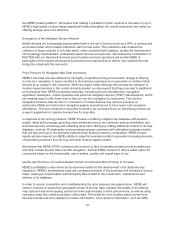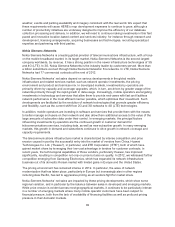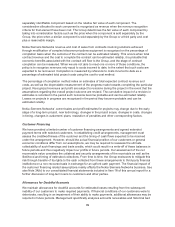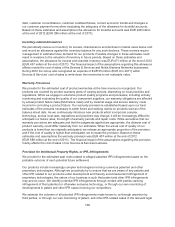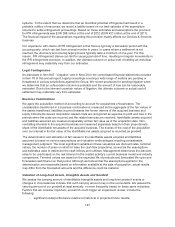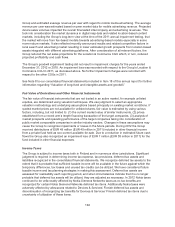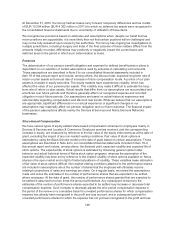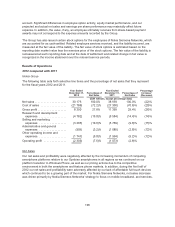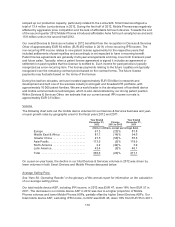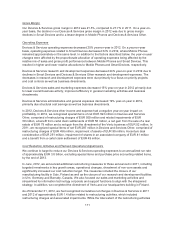Nokia 2012 Annual Report Download - page 102
Download and view the complete annual report
Please find page 102 of the 2012 Nokia annual report below. You can navigate through the pages in the report by either clicking on the pages listed below, or by using the keyword search tool below to find specific information within the annual report.systems. To the extent that we determine that an identified potential infringement will result in a
probable outflow of resources, we record a liability based on our best estimate of the expenditure
required to settle infringement proceedings. Based on these estimates and assumptions the provision
for IPR infringements was EUR 388 million at the end of 2012 (EUR 431 million at the end of 2011).
The financial impact of the assumptions regarding this provision mainly affects our Devices & Services
business.
Our experience with claims of IPR infringement is that there is typically a discussion period with the
accusing party, which can last from several months to years. In cases where a settlement is not
reached, the discovery and ensuing legal process typically lasts a minimum of one year. For this
reason, IPR infringement claims can last for varying periods of time, resulting in irregular movements in
the IPR infringement provision. In addition, the ultimate outcome or actual cost of settling an individual
infringement may materially vary from our estimates.
Legal Contingencies
As discussed in Item 8A7. “Litigation” and in Note 29 to the consolidated financial statements included
in Item 18 of this annual report, legal proceedings covering a wide range of matters are pending or
threatened in various jurisdictions against the Group. We record provisions for pending litigation when
we determine that an unfavorable outcome is probable and the amount of loss can be reasonably
estimated. Due to the inherent uncertain nature of litigation, the ultimate outcome or actual cost of
settlement may materially vary from estimates.
Business Combinations
We apply the acquisition method of accounting to account for acquisitions of businesses. The
consideration transferred in a business combination is measured as the aggregate of the fair values of
the assets transferred, liabilities incurred towards the former owners of the acquired business and
equity instruments issued. Acquisition-related costs are recognized as expense in profit and loss in the
periods when the costs are incurred and the related services are received. Identifiable assets acquired
and liabilities assumed are measured separately at their fair value as of the acquisition date. Non-
controlling interests in the acquired business are measured separately based on their proportionate
share of the identifiable net assets of the acquired business. The excess of the cost of the acquisition
over our interest in the fair value of the identifiable net assets acquired is recorded as goodwill.
The determination and allocation of fair values to the identifiable assets acquired and liabilities
assumed is based on various assumptions and valuation methodologies requiring considerable
management judgment. The most significant variables in these valuations are discount rates, terminal
values, the number of years on which to base the cash flow projections, as well as the assumptions
and estimates used to determine the cash inflows and outflows. Management determines the discount
rates to be used based on the risk inherent in the related activity’s current business model and industry
comparisons. Terminal values are based on the expected life of products and forecasted life cycle and
forecasted cash flows over that period. Although we believe that the assumptions applied in the
determination are reasonable based on information available at the date of acquisition, actual results
may differ from the forecasted amounts and the difference could be material.
Valuation of Long-lived Assets, Intangible Assets and Goodwill
We assess the carrying amount of identifiable intangible assets and long-lived assets if events or
changes in circumstances indicate that such carrying amount may not be recoverable. We assess the
carrying amount of our goodwill at least annually, or more frequently based on these same indicators.
Factors that we consider important, and which could trigger an impairment review, include the
following:
• significant underperformance relative to historical or projected future results;
101


